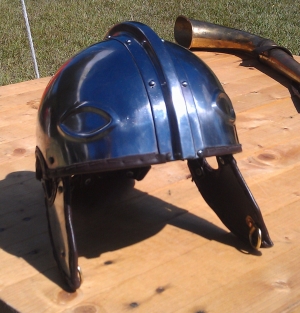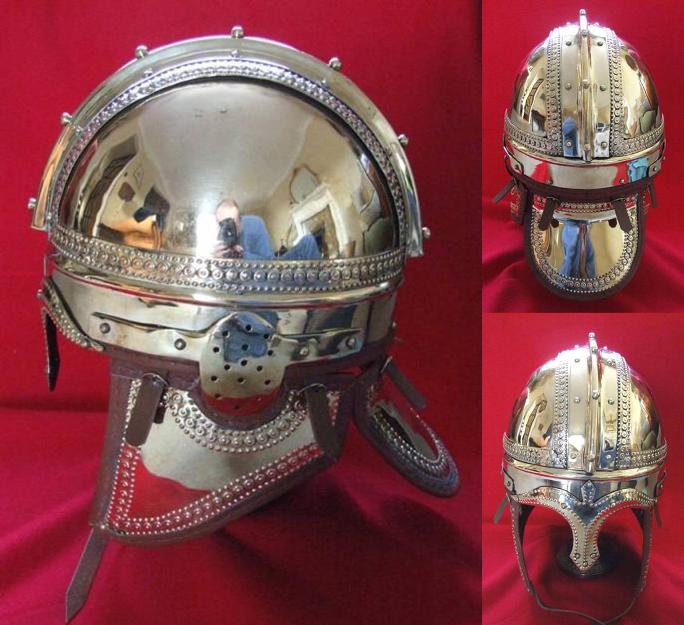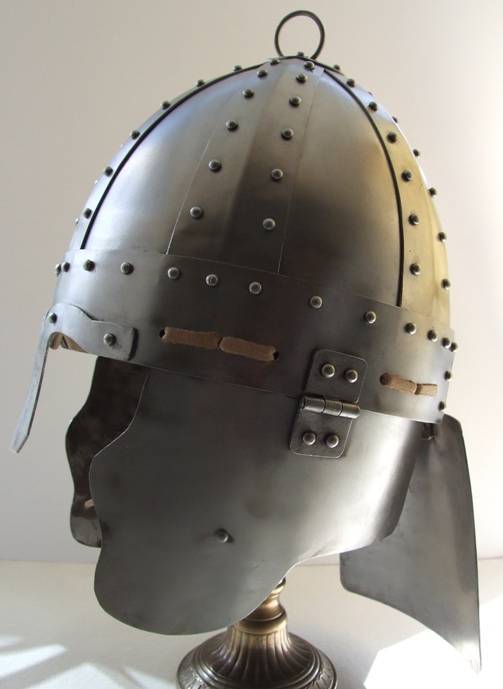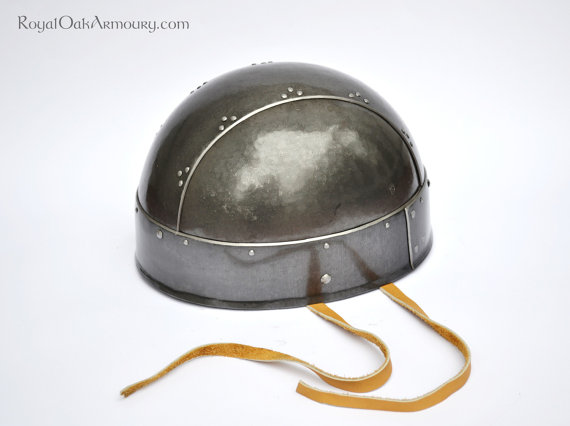Bipartite Ridge Helmet
WHERE TO BUY:
Armamentaria - Excellent Intercisa-IV helmet. It could use a leather edging or lining, but other than that is spectacular. Highly recommended.
Soul of the Warrior - Offers the Intercisa-I and Intercisa-II type ridge helmets. The cheekpieces can get mixed up on these helmets. However, they are acceptable for a beginning impression.
Quadripartite Ridge Helmet
The second type of ridge helmet had a 4-piece bowl construction. The Berkasovo-type is named after the finds in Berkasova and Deurne, being the first of this type of construction found. Some finds include the Koblenz, Concesti, and Burgh Castle helmets, which date to the late 4th or early 5th century. Ridge helmets of this type are comprised of four sections joined together into a bowl by a central ridge and two plates on the side, and had a leather lining or edging. These helmets had a larger set of cheekpieces compared to their intercisa counterparts, and usually a base ring and nasal. Their usage seems to have stopped in the late 5th century, after the collapse of the Roman army in the West, and were replaced by spangenhelmets and banded helmets. The influence of this helmet lasted into the so called 'dark ages' and inspired helmets like the Pioneer helmet. Although it's easier to buy ridge helmets, they are rather easy to make.
WHERE TO BUY:
Soul of the Warrior - Sells the Deepeeka Burgh Castle Helmet, we prefer the version without earholes. The Deepeeka Deurne Helmet, if you shape the cheekpieces to curve with your face, is also acceptable. SOTW also offers the Al-Hamdd Koblenz helmet, which is highly recommended for 5th century impressions.
Armamentaria - Excellent Koblenz helmet, based on the original late 4th century finds. Highly recommended.
Hans Binfeld Replicas - High quality Burgh Castle helmet. Great for any late Roman impression, but more expensive.
Spangenhelmet
The Spangenhelmet is a pointed-bowl helmet made of four or more plates, joined together by several bands. These helmets likely originated amongst the barbarians or Sassanid Persians, but my have also originated in Egypt. They became popular in the Roman army beginning in the 5th century, and by the late 6th century virtually the whole East Roman Army used Baldenheims. The Leiden and Sinj helmets are prime examples, the latter of which dates to the 5th century AD. Like the ridge helmets, they are easy to make, but easier to buy.
WHERE TO BUY:
Armamentaria - Sells the Deir El Medineh Helmet, which dates from the 3rd to 7th centuries. An excellent helmet, if a little bit more expensive. Highly Recommended.
Die Ritterschmiede - Sells several Baldenheims, but only one is acceptable for our timeframe, which is the model 1030-0140. Good replica of this style of helmet.
Banded Helmet
The banded helmet may have descended in part from the ridge helmet, but likely had been around for much longer. These helmets were introduced to the 5th century army by barbarian foederati, and became very popular amongst the successor realms, particularly the Visigoths, Saxons, and Franks. A find dating to this era is the Shorwell helmet, in late 5th century Britain, although there are others including Hunnic examples. These are much easier to make than to buy, but if you don't have the time to invest there are places at which they can be purchased.
WHERE TO BUY:
Royal Oak Armory - Sells what is probably the best banded helmet available, and is very well done.
Cristae
WHERE TO BUY:
Soul of the Warrior - Will make a custom feather or horsehair crest for your helmet. Takes quite a bit of time, but they will deliver.



